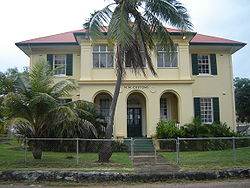Thursday Island
| Thursday Island Queensland | |||||||||
|---|---|---|---|---|---|---|---|---|---|
 View of the Township of Thursday Island | |||||||||
| Population | 2,682 | ||||||||
| Postcode(s) | 4875 | ||||||||
| Elevation | 8.0 m (26 ft) | ||||||||
| Location |
| ||||||||
| LGA(s) | Shire of Torres | ||||||||
| State electorate(s) | Cook | ||||||||
| Federal division(s) | Leichhardt | ||||||||
| |||||||||
Thursday Island, also known as TI or Waiben, is the administrative and commercial centre of the Torres Strait Islands. Lying 39 km north of Cape York Peninsula, Queensland, in the Torres Strait, Thursday Island has an area of about 3.5 km² and an estimated population of 3,500. The highest point on Thursday Island, standing at 104 metres above sea level, is Milman Hill, a World War II defence facility. Thursday Island experiences a tropical climate with an average daily temperature of 29 degrees Celsius. The hottest month is traditionally November (31.4 degrees Celsius) while the coldest is July (27.6 degrees Celsius). January typically experiences the highest rainfall (389 mm) and September and October average 3 mm.
History
The island has been populated for thousands of years by the Melanesian Torres Strait Islanders, who named the island Waiben, thought to mean 'no water or place of no water', owing to the scarcity of fresh water on the island. In 1877, an administrative centre for the Torres Strait Islands was set up on the island by the Queensland Government and a township developed over the next decade.
A lucrative pearling industry was founded on the island in 1885, attracting workers from around Asia, including Japan, Malaya and India, seeking their fortune. Additionally, many south Pacific Islanders were also imported to work in the industry, many against their will. While the pearling industry has declined in importance, the mix of cultures is evident to this day. The pearling industry centred on the harvesting of pearl shell, which was used to make shirt buttons. Pearls themselves were rare and a bonus for the owner or crew. The boats used were a very graceful two-masted lugger with, in good times, a stern diver, one midships, and one diver off the bow. A manual air compressor was used. It looked like a yard-wide cube with two large wheels mounted one on each side. Two crew men, generally Torres Straits Islanders, would stand, one at each wheel, and turn the wheels to compress the air for the diver. The divers wore a corslet on their upper body with a diver's hardhat attached to it. They then had a pair of canvas trousers and simple rubber shoes on their feet. The theory was that they could get out of this outfit quickly and return to the surface as needed. The waters of the Straits are murky and visibility was generally very poor. Depths of dive were not great except at the Darnley Deep which was 40 fathoms (240 feet). Attacks of the bends were common and deaths frequent.

During World War II, Thursday Island became the military headquarters for the Torres Strait and was a base for Australian and United States forces. As a result, the island was bombed by the Japanese in 1942, which saw the evacuation of civilians from the island. They did not return until after the end of the war. The island itself was not bombed during the Second World War (except, of course, in 1942, which was in fact during world war two), due, it was thought, to it being the burial place of many Japanese pearlshell divers. However, neighbouring Horn Island was bombed. It had an airbase there, used by the Allies to attack parts of New Guinea. Following the conclusion of the war the island tradition of a no footwear policy was reinstated in respect for the ancient spirits believed to reside on the island .After the war an airline service was set up by Ansett Airlines from Cairns to TI, on Wednesday and Saturdays, using de Havilland Dragon Rapides and later DC3s. Passengers disembarked on Horn Island and caught a ferry-boat over to TI. The island was also served by a ship, the Elsana, which made the journey once a month. Currently, Qantas flies daily to Horn Island using Dash 8 planes.
The Melanesian background of the Thursday Islanders became an issue in the 1970s, when Papua New Guinea sought to include the Torres Strait Islands within its borders. The Torres Strait Islanders insisted that they were Australians, however, and after considerable diplomatic discussion all of the Torres Strait, including Thursday Island, remained part of Australia.
Economy
TI is one of the two bases for the Torres Straits Pilots, a cooperative owned and run by qualified Master Mariners who pilot ships through the Straits and down to Cairns. This is a necessary service because navigation through the area is tricky due to the extensive reef systems.
The economy of the island is supported by pearling and fishing, as well as a fast-developing tourism industry, with perhaps the most famous tourists being novelist Somerset Maugham and Banjo Paterson. Somerset Maugham wrote two of his famous Short Stories while staying at the old Grand Hotel on Thursday Island, namely "German Harry" - see http://www.riverbendnelligen.com/germanharry.html - and "French Joe" - see http://www.riverbendnelligen.com/frenchjoe.html . Both those characters are based on real people who lived in the Torres Strait.
English is the official language of Thursday Island, although Torres Strait Creole is predominant on a social level.[1]
Township
The Thursday Island township is noteworthy for being the most northerly town in Australia. It is the administrative centre of the Shire of Torres. The Torres Strait Campus of the Tropical North Queensland TAFE Institute located on the island next to the high school is the leader in education for the Torres Strait.
References
This article needs additional citations for verification. (January 2008) |
